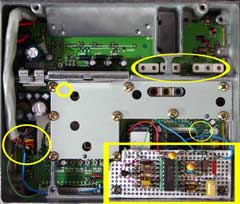
click for larger image (124KB)
This photo shows the inside of the modified TK-931. Areas of modification (highlighted in yellow) include:
 click for larger image (124KB) |
This photo shows the inside of the modified TK-931. Areas of modification (highlighted in yellow) include: |
The front-end of the TK-931 consists of a three-pole dielectric filter followed by a low-noise amplifier transistor (2SC4093) followed by an additional 4-pole dielectric filter. The LNA transistor is specified over a fairly wide frequency range, so there is no problem operating in the 902 band. The filters, on the other hand, have a + 12.5 MHz bandwidth. The original filters were centered at 938 MHz to cover the intended 935 to 941 receive range. To handle the frequency change, both filters must be replaced. Although an optimum filter for repeater receive operation would be centered around 902 MHz, the easiest filters to obtain are centered at 915 MHz. Their availability is probably associated with all the ISM applications which can make use of them. These filters also have the benefit of working for repeater or mobile service, as they cover 902 to 928 MHz. The pre-LNA filter is pretty easy to come by. You can find Toko or Murata filters from various sources. This three-pole filter is the same part that is used for modification of Motorola Maxtrac radios to amateur service. The part that I used was a Toko 6DFB-915E-10. The four-pole filter is a little trickier. While Toko does list a four-pole part that would be appropriate for repeater use (6DFC-902E-10), inventories of this rather specialized part appear to be pretty thin. What is typically done instead (and can be applied to repeater or mobile service) is to construct the physically equivalent part from two 2-pole filters. Either two Toko 6DFA-915E-10 or Murata DFC2R915 parts can be used.
The first step in replacing the filters is to remove the original components. The filters are thru-hole parts. To gain easy access to the filter pins, the transmitter shield should be removed from the bottom side of the main circuit board. The shield is held in place by three (gold) screws to main chassis and by two (black) screws that also secure the bottom receiver shield. Once the shield is removed, the filters should be carefully unsoldered from the circuit board. Insert the new filters and then reinstall the transmitter shield. After filter replacement, the matching capacitor (TC300) should be adjusted to produce best receiver sensitivity.
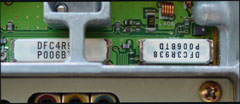 click for larger image (44KB) |
Original filters in place. |
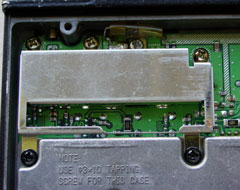 click for larger image (92KB) |
This shield should be taken-off to gain easy access to the filter pins. It is held in place with the three gold screws at the top and the two black screws that are screwed into the receive shield. |
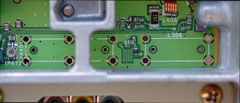 click for larger image (44KB) |
This shows the main circuit board after the filters have been removed. |
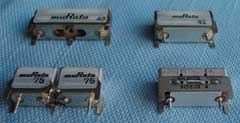 click for larger image (32KB) |
The two original (4-pole and 3-pole) 938 MHz filters and the replacement dual 2-pole and 3-pole 915 MHz filters. |
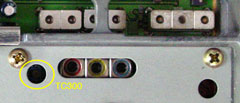 click for larger image (32KB) |
The final configuration with the replacement filters installed. After filters have been changed, the matching capacitor (TC300) should be adjusted to obtain best receive sensitivity |
The receiver operating frequency range of the stock TK-931 is 935 to 941 MHz. The tuning range of the VCO is adequate to handle normal mobile receive operation in the 927 MHz band. For reliable repeater performance in the 902 MHz band, it is necessary to slightly modify the VCO to accommodate the frequency shift. The modification simply requires the addition of a small capacitor from one end of the VCO tuning coil to ground.
 click for larger image (84KB) |
The added VCO capacitor needs to be placed on the bottom side of the radio circuit board. This portion of the circuit is under the lower shielding cover. To access the circuit board, the Final Section Shield must first be removed. This shield is attached with five screws, two of which also attach the Lower Shielding Cover to the circuit board. Once the shield is removed, the larger shielding cover can be removed by extraction of the remaining seven screws. |
 click for larger image (84KB) |
With the shielding removed, the VCO circuitry needs to be located. With the radio oriented with the rear panel facing upwards, the VCO circuitry is located in the top-right corner of the area previously covered by the shielding cover. The capacitor will be added bewtween the top-right post of the VCO coil (coil located on opposite side of circuit board) and ground. |
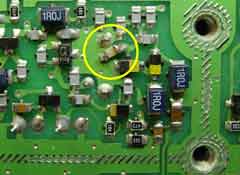 click for larger image (40KB) |
To shift the frequency range of the VCO, a 2.2 - 4.0 pF capacitor is added between the VCO coil post and ground. A high quality ceramic disc or chip capacitor should be used (chip capacitor shown). Once the capacitor is installed, the shields can be replaced. Note: After the capacitor is added, the receiver most likely will not operate in the normal 927 MHz range. The radio should be reprogrammed for the 902 MHz repeater input range and checked for VCO lock. |
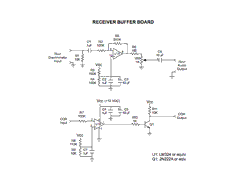 click for larger image (16KB) |
This is the schematic of a simple op-amp based circuit used to provide buffered discriminator audio and COR to the controller. The gain of the audio stage was chosen to produce roughly 2 volt peak-to-peak for a 1 kHz audio tone with a deviation of 2.5 kHz. |
 click for larger image (100KB) |
The above circuit was implemented on a copperclad perf-board. An LM324 quad op-amp was used. Only two of the stages were needed, but these single-supply low power amplifiers are readily available and I had the space. |

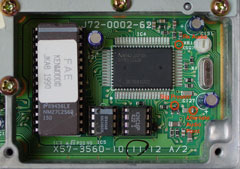 click for larger image (200KB) |
This photo shows the interface points for the Audio/COR board. The small via near the corner of the microprocessor IC (IC4) is the discriminator audio pick-off point. The COR input to the buffer board can be wired to the interface between R118 and D101 of the receiver board. |
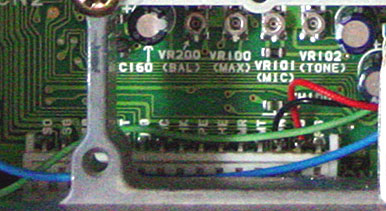 |
DC input to the Audio/Interface board can be taken from the CN1 connector (connects front panel to main circuit board). Switched 13.8 VDC is on pin 2 (SB) and return is on pin 3 (GN). |
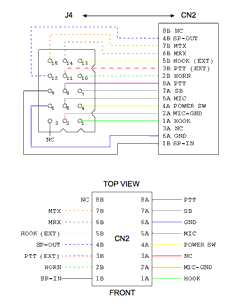 click for larger image (16KB) |
The J4 accessory connector is routed to an internal circuit board connector (CN2) via a multi-conductor cable. This diagram shows the factory wiring between the two connectors. The colors reflect the color coding or the wires in the cable. |
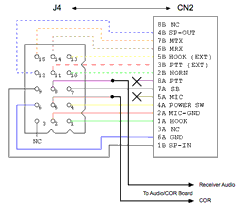 click for larger image (12KB) |
At the CN2 side of the J4 cable, cut the brown wire going to pin 5A (pin 5 of J4) and the purple wire going to pin 8A (pin 8 of J4). Reconnect the brown wire that runs back to J4 to the COR output of the Audio/COR buffer board. Reconnect the purple wire that runs back to J4 to the audio output of the Audio/COR buffer board. Note that it may be necessary to remove some of the cable jacket to gain easy access to the internal wires. The previous connections on CN2 connector can remain unterminated. |
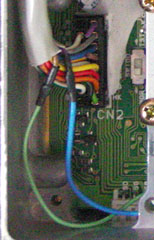 click for larger image (44KB) |
| J5 Pin | Signal |
|---|---|
| 1 | CTCSS Enable (ground to enable) |
| 5 | COR (low when signal present) |
| 6 | Ground |
| 8 | Receive Audio ( 2 V P-P, 2.5 kHz dev, 1 kHz rate) |
| 9 | Speaker In (Loop to pin 12) |
| 12 | Speaker Out (Loop to pin 9) |